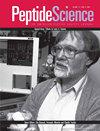A conserved β‐bulge glycine residue facilitates folding and increases stability of the mouse α‐defensin cryptdin‐4
IF 1.5
4区 生物学
Q4 BIOCHEMISTRY & MOLECULAR BIOLOGY
引用次数: 0
Abstract
Defensins are key components of both innate and adaptive immune responses to pathogens. Cryptdins are mouse alpha‐defensins that are secreted from Paneth cells in the small intestine and have disulfide‐stabilised structures and antibacterial activities against both Gram‐positive and Gram‐negative bacteria. The folding and three‐dimensional structures of alpha‐defensins are thought to depend on a conserved glycine residue that forms a β‐bulge. Here we investigated the role of this conserved glycine at position 19 of cryptdin‐4 (Crp4) in terms of the folding, structure and stability. A Crp4 variant with D‐Ala at position 19 folded efficiently, was stabilised by a large number of hydrogen bonds, and resisted proteolysis in simulated intestinal fluid. Although a variant with L‐Ala at position 19 was able to adopt the correct fold, it showed less efficient folding and was degraded more rapidly than the D‐Ala variant. These results demonstrate the key role that glycine residues can have in folding of bioactive peptides and can provide insights to guide design of stable antimicrobial peptides that fold efficiently.保守的β凸起甘氨酸残基促进小鼠α防御素密码子蛋白-4的折叠并增加其稳定性
防御素是对病原体的先天免疫反应和适应性免疫反应的关键组成部分。Cryptdins是小鼠α防御素,由小肠中的Paneth细胞分泌,具有二硫化物稳定的结构和对革兰氏阳性和革兰氏阴性细菌的抗菌活性。α防御素的折叠和三维结构被认为取决于形成β凸起的保守甘氨酸残基。在这里,我们研究了密码子蛋白-4(Crp4)19位的这种保守甘氨酸在折叠、结构和稳定性方面的作用。在19位具有D‐Ala的Crp4变体有效折叠,通过大量氢键稳定,并在模拟肠液中抵抗蛋白水解。尽管在19位具有L‐Ala的变体能够采用正确的折叠,但其折叠效率较低,降解速度比D‐Ala变体更快。这些结果证明了甘氨酸残基在生物活性肽折叠中的关键作用,并为指导有效折叠的稳定抗菌肽的设计提供了见解。
本文章由计算机程序翻译,如有差异,请以英文原文为准。
求助全文
约1分钟内获得全文
求助全文
来源期刊

Peptide Science
Biochemistry, Genetics and Molecular Biology-Biophysics
CiteScore
5.20
自引率
4.20%
发文量
36
期刊介绍:
The aim of Peptide Science is to publish significant original research papers and up-to-date reviews covering the entire field of peptide research. Peptide Science provides a forum for papers exploring all aspects of peptide synthesis, materials, structure and bioactivity, including the use of peptides in exploring protein functions and protein-protein interactions. By incorporating both experimental and theoretical studies across the whole spectrum of peptide science, the journal serves the interdisciplinary biochemical, biomaterials, biophysical and biomedical research communities.
Peptide Science is the official journal of the American Peptide Society.
 求助内容:
求助内容: 应助结果提醒方式:
应助结果提醒方式:


